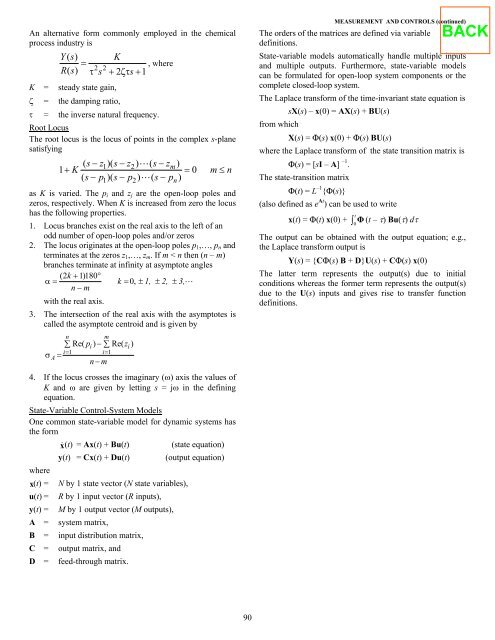fundamentals of engineering supplied-reference handbook - Ventech!
fundamentals of engineering supplied-reference handbook - Ventech!
fundamentals of engineering supplied-reference handbook - Ventech!
You also want an ePaper? Increase the reach of your titles
YUMPU automatically turns print PDFs into web optimized ePapers that Google loves.
An alternative form commonly employed in the chemical<br />
process industry is<br />
Y() s K<br />
= , where<br />
Rs () 2 2<br />
τ s + 2ζτ s+<br />
1<br />
K = steady state gain,<br />
ζ = the damping ratio,<br />
τ = the inverse natural frequency.<br />
Root Locus<br />
The root locus is the locus <strong>of</strong> points in the complex s-plane<br />
satisfying<br />
( s−z1)( s−z2) �(<br />
s−zm) 1+ K = 0 m≤n ( s− p1)( s− p2) �(<br />
s− pn)<br />
as K is varied. The pi and zj are the open-loop poles and<br />
zeros, respectively. When K is increased from zero the locus<br />
has the following properties.<br />
1. Locus branches exist on the real axis to the left <strong>of</strong> an<br />
odd number <strong>of</strong> open-loop poles and/or zeros<br />
2. The locus originates at the open-loop poles p1,…, pn and<br />
terminates at the zeros z1,…, zm. If m < n then (n – m)<br />
branches terminate at infinity at asymptote angles<br />
(2k + 1)180°<br />
α= k = 0, ± 1, ± 2, ± 3, �<br />
n−m with the real axis.<br />
3. The intersection <strong>of</strong> the real axis with the asymptotes is<br />
called the asymptote centroid and is given by<br />
σ =<br />
A<br />
n m<br />
∑ pi − ∑ zi<br />
i= 1 i=<br />
1<br />
Re( ) Re( )<br />
n−m 4. If the locus crosses the imaginary (ω) axis the values <strong>of</strong><br />
K and ω are given by letting s = jω in the defining<br />
equation.<br />
State-Variable Control-System Models<br />
One common state-variable model for dynamic systems has<br />
the form<br />
x�<br />
(t) = Ax(t) + Bu(t) (state equation)<br />
y(t) = Cx(t) + Du(t) (output equation)<br />
where<br />
x(t)<br />
= N by 1 state vector (N state variables),<br />
u(t) = R by 1 input vector (R inputs),<br />
y(t) = M by 1 output vector (M outputs),<br />
A = system matrix,<br />
B = input distribution matrix,<br />
C = output matrix, and<br />
D = feed-through matrix.<br />
90<br />
MEASUREMENT AND CONTROLS (continued)<br />
The orders <strong>of</strong> the matrices are defined via variable<br />
definitions.<br />
State-variable models automatically handle multiple inputs<br />
and multiple outputs. Furthermore, state-variable models<br />
can be formulated for open-loop system components or the<br />
complete closed-loop system.<br />
The Laplace transform <strong>of</strong> the time-invariant state equation is<br />
sX(s) – x(0) = AX(s) + BU(s)<br />
from which<br />
X(s) = Φ(s) x(0) + Φ(s) BU(s)<br />
where the Laplace transform <strong>of</strong> the state transition matrix is<br />
Φ(s) = [sI – A] –1 .<br />
The state-transition matrix<br />
Φ(t) = L –1 {Φ(s)}<br />
(also defined as e At ) can be used to write<br />
x(t) = Φ(t) x(0) + ∫ t<br />
Φ (t – τ) Bu(τ) dτ<br />
0<br />
The output can be obtained with the output equation; e.g.,<br />
the Laplace transform output is<br />
Y(s) = {CΦ(s) B + D}U(s) + CΦ(s) x(0)<br />
The latter term represents the output(s) due to initial<br />
conditions whereas the former term represents the output(s)<br />
due to the U(s) inputs and gives rise to transfer function<br />
definitions.
















